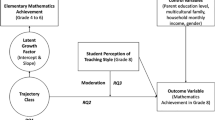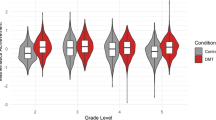Abstract
This study examines the relationship between mathematics achievement and television viewing. The data consist of 13,542 high school seniors from the High School and Beyond project conducted by U.S. Department of Education, National Center for Education Statistics. A feed-forward neural network is employed as a nonlinear model. A curvilinear relationship is found, independent of viewer characteristics, parental background, parental involvement, and leisure activities, with a peak at about one hour of viewing, and persistent upon the inclusion of statistical errors. It is further shown that for low-ability students the curvilinearity is replaced with an entirely positive correlation across all hours of television viewing.
Similar content being viewed by others
References
Anderson, D. R. & Lorch, E. P. (1983). Looking at television: Action or reaction. In: J. Bryant & D. R. Anderson (eds), Children's Understanding of Television: Research on Attention and Comprehension. New York: Academic Press, pp. 1–34.
Anderson, D. R. & Smith, R. (1984). Young children's TV viewing: The problems with cognitive continuity. In: F. J. Morrison, C. Lord & D. F. Keating (eds), Advances in Applied Developmental Psychology, Vol. 1. New York: Academic Press.
Beentjes, J. W. M. & van der Voort, T. J.A. (1988). Television's impact on children's reading skills: A review of research. Reading Research Quarterly 23: 389–413.
Bishop, C. M. (1996). Neural Networks for Pattern Recognition. Oxford: Clarendon Press.
Cheng, B. & D. M. Titterington (1994). Neural networks: A review from a statistical perspective. Statistical Science 9: 2–54.
Collins, W. A. (1982). Cognitive processing in television viewing. In: D. Pearl, L. Bouthilet & J. Lazar (eds), Television and Behavior: Ten Years of Scientific Progress and Implications for the Eighties: Vol. 2. Technical Reviews. Rockville, MD: National Institute of Mental Health, pp. 9–23.
Comstock, G. & Paik, H. (1991). Television and the American Child. New York: Academic Press.
Davies, D., Bathurst, D. & Bathurst, R. (1990). The Telling Image: The Changing Balance Between Pictures and Words in a Technological Age. Oxford: Clarendon Press.
Draper, N. R. & Smith, H. (1981). Applied Regression Analysis. New York: John Wiley and Sons.
Fetler, M. (1984). Television viewing and school achievement. Journal of Communication 34: 104–118.
Fosarelli, P. (1986). In my opinion... Advocacy for children's appropriate viewing of television: What can we do? Children's Health Care 15: 79–80.
Garson, D. G. (1991). A comparison of neural network and expert systems algorithms with common multivariate procedures for analysis of social science data. Social Science Computer Review 9: 399–434.
Gaddy, G. D. (1986). Television's impact on high school achievement. Public Opinion Quarterly 50: 340–359.
Greenstein, J. (1954). Effects of television upon elementary school grades. Journal of Educational Research 48: 161–176.
Gutfreund, H. & Toulouse, G. (eds) (1994). Biology and Computation. Advanced Series in Neuroscience: Vol. 3. Singapore: World Scientific Publishing Company.
Haertel, E. H. & Wiley, D. E. (1978). Social and Economic Differences in Elementary School Achievement. Chicago: ML-Group for Policy Studies in Education, CEMREL, Inc.
Hornik, K., Stinchcombe, M. & White, H. (1989). Multilayer feedforward networks are universal approximators. Neural Networks 2: 359–366.
Huston, A. & Wright, J. C. (1989). The forms of television and the child viewer. In: G. Comstock (ed.), Public Communication and Behavior, Vol. 2. New York: Academic Press, pp. 103–159.
Keith, T. Z., Reimers, T. M., Fehrmann, P. G., Pottebaum, S. M. & Aubey, L. W. (1986). Parental involvement, homework, and TV time: Direct and indirect effects on high school achievement. Journal of Educational Psychology 78: 373–380.
Lapointe, A. E., Mead, N. A. & Askew, J. M. (1992). Learning Mathematics. Princeton, N.J.: Educational Testing Service.
Lapointe, A. E., Mead, N. A. & Phillips, G. W. (1989). A World of Differences: International Assessment of Educational Progress. Princeton, N.J.: Educational Testing Service.
Marzban, C. & Stumpf, G. J. (1996). A neural network for tornado prediction based on Doppler radar-derived attributes. Journal of Applied Meteorology 35: 617–626.
Masters, T. (1993). Practical Neural Network Recipes in C++. Academic Press, Inc.
Meraviglia, C. (1996). Models of representation of social mobility and inequality systems. A neural network approach. Quality & Quantity 30: 231–252.
Morgan, M. & Gross, L. (1982). Television and educational achievement and aspiration. In: D. Pearl, L. Bouthilet & J. Lazar (eds), Television and Behavior: Ten Years of Scientific Progress and Implications for the Eighties: Vol. 2. Technical Reviews. Washington, DC: Government Printing Office, pp. 78–90.
Muller, B. & Reinhardt, J. (1990). Neural Networks; An Introduction. Physics of Neural Networks Series. Berlin; New York: Springer-Verlag.
National Institute of Mental Health (1982). Television and Behavior: Ten Years of Scientific Progress and Implications for the Eighties (DHHS Publication No. ADM 82-1195).Washington, DC: U.S. Government Printing Office.
Van Nelson, C. & Neff, K. J. (1990). Comparing and contrasting neural net solutions to classical statistical solutions. Paper presented at the Annual Meeting of the Midwestern Educational Research Association (Chicago, IL). (ERIC Document Reproduction Service No. ED 326-577.)
Neuman, S. B. (1988). The displacement effect: Assessing the relation between television viewing and reading performance. Reading Research Quarterly 23: 414–440.
Paik, H. & Marzban, C. (1995). Predicting television extreme viewers and nonviewers: A neural network analysis. Human Communication Research 22: 284–306.
Potter, W. J. (1987). Does television viewing hinder academic achievement among adolescents? Human Communication Research 14: 27–46.
Ridley-Johnson, R., Cooper, H. & Chance, J. (1983). The relation of children's television viewing to school achievement and I.Q. Journal of Educational Research 76: 294–297.
Ripley, B. D. (1996). Pattern Recognition and Neural Networks. Cambridge: Cambridge University Press.
Salomon, G. (1994). Interaction of Media, Cognition and Learning. Hillsdale, NJ: Lawrence Erlbaum Associates.
Sarle, W. S. (1994a). Neural networks and statistical models in SAS Institute Inc. Proc. Nineteenth Annual SAS Users Group International Conference, Cary, NC: SAS Institute Inc. (ftp://ftp.sas.com/pub/neural/neural1.ps.), pp. 1538–1550.
Sarle, W. S. (1994b). Neural network implementation in SAS Software in SAS Institute Inc. Proc. Nineteenth Annual SAS Users Group International Conference, Cary, NC: SAS Institute Inc., pp. 1551–1573.
Sharman, K. (1979). Children's Television Behaviour: Its Antecedents and Relationships to School Performance. ACER Occasional Paper 14.
Stone, M. (1974). Cross-validatory choice and assessment of statistical predictions. Journal of the Royal Statistical Society B 36: 111–147.
U.S. Department of Education, National Center for Education Statistics (1992). National Education Longitudinal Study, 1988: First Follow-up (1990). [Student Data] [Computer file]. U.S. Department of Education, Office of Educational Research and Improvement [producer], 1992. Ann Arbor, MI: Inter-university Consortium Political and Social Research [distributor], 1992.
Wahba, G. & Wold, S. (1975). A completely automatic French curve: fitting spline functions by cross-validation. Communications in Statistics, Series A 4: 1–17.
Williams, P. A., Haertel, E. H., Haertel, G. D. & Walberg, J. (1982). The impact of leisure-time television on school learning: A research synthesis. American Educational Research Journal 19: 19–50.
Woelfel, J. (1993). Artificial neural networks in policy research: A current assessment. Journal of Communication 43: 63–80.
Zillmann, D. (1982). Television viewing and arousal. In: D. Pearl, L. Bouthilet & J. Lazar (eds), Television and Behavior: Ten Years of Scientific Inquiry and Implications for the Eighties: Vol. 2. Technical Reviews. Washington, DC: U.S. Government Printing Office, pp. 53–67.
Zillmann, D., Williams, B. R., Bryant, J., Boynton, K. R. & Wolf, M. A. (1980). Acquisition of information from educational television programs as a function of differently paced humorous inserts. Journal of Educational Psychology 72: 170–180.
Author information
Authors and Affiliations
Rights and permissions
About this article
Cite this article
Paik, H. Television Viewing and High School Mathematics Achievement: A Neural Network Analysis. Quality & Quantity 34, 1–15 (2000). https://doi.org/10.1023/A:1004795407624
Issue Date:
DOI: https://doi.org/10.1023/A:1004795407624




